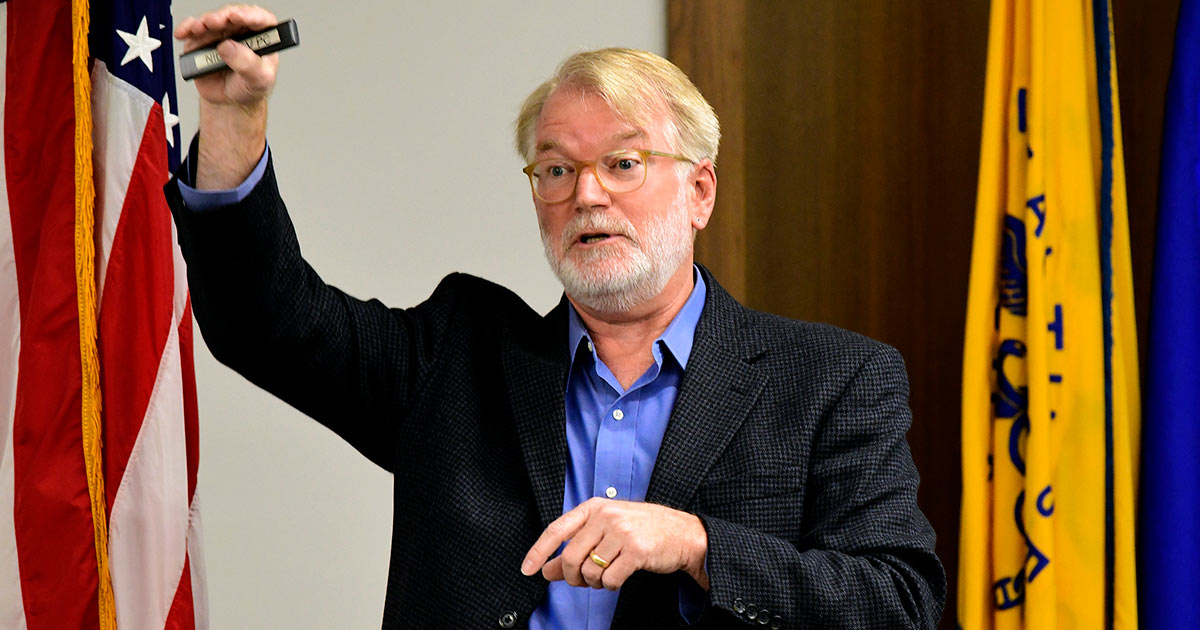Well known for his influential work on the neurotoxicity of low-level lead exposure, Bruce Lanphear, M.D., said he now believes storytelling is the most critical tool we need to protect people from toxic chemicals and pollutants.
“We absolutely will always need science, but we need to be able to communicate the science,” he said in his Nov. 18 Keystone Science Lecture at NIEHS.
Lanphear is a professor of health sciences at Simon Fraser University. The lecture was co-hosted by Kimberly Gray, Ph.D., health scientist administrator in the Division of Extramural Research and Training Division, and Kyla Taylor, Ph.D., health scientist in the Division of Translational Toxicology.
“Dr. Lanphear emphasized the importance of the science that NIEHS supports, manages, and conducts in providing the evidence needed to drive change, and the essential role we have in communicating the science to protect the well-being of our communities,” said Gray.
Story drives action
“Story is what helps us drive certain types of investment in research,” Lanphear explained. “How much evidence do we need to take action? That’s driven by story, not by the science.”
Highlighting the role of storytelling at each juncture, Lanphear told the story of U.S. federal lead exposure regulation from 100 years ago to the present (see sidebar). This period spans from the time before any regulations existed to the current understanding that no safe level of lead has been identified.
He demonstrated how key events and scientific research have driven the narrative arc and resulted in increasing regulations to limit exposure. Notable moments included the following.
- A 1924 industrial exposure that killed five workers and poisoned over 80 during production of leaded gasoline. The resulting “Kehoe Rule” by a federal commission set a precedent requiring scientific evidence of toxicity before government agencies could prohibit the use of leaded gasoline.
- In 1979, researchers found children with higher tooth lead levels showed more behavioral problems in school.
- Lead poisoning of Millie, the dog of President George H.W. Bush and First Lady Barbara Bush, happened during White House renovations in 1991. Subsequent attention focusing on the millions of children affected by lead poisoning, particularly those living in older inner city dwellings, resulted in passage of the Residential Lead-Based Paint Hazard Act of 1992. This act called for research to determine what level of lead in house dust is dangerous.
- A 2006 paper that argued for lowering the threshold for blood lead levels, which trigger actions to remove sources of lead exposure, from 10 to 2 micrograms per deciliter.
- Publication of the National Toxicology Program Monograph, “Health Effects of Low-Level Lead,” in 2012 and recognition by the U.S. Centers of Disease Control and Prevention that no safe level of lead had been identified in children.

Lanphear also shared research linking lead exposure to lower IQ levels, preterm birth, and coronary heart disease. He showed a steep decline in blood lead levels in the U.S. since the 1970s, which correlated with new public health policies. These policies included bans on lead in gasoline, residential paint, plumbing, and food cans and the establishment of lead dust and soil hazard standards.
He emphasized that to bring about fundamental change, environmental health scientists need to find ways to remain in the field for decades without losing hope.
“It has been a hundred years with just the contemporary lead pandemic,” Lanphear said, “but we have seen change.”
(Elizabeth Witherspoon, Ph.D., is a contract technical writer in the NIEHS Office of Communications and Public Liaison.)
Source link
factor.niehs.nih.gov

